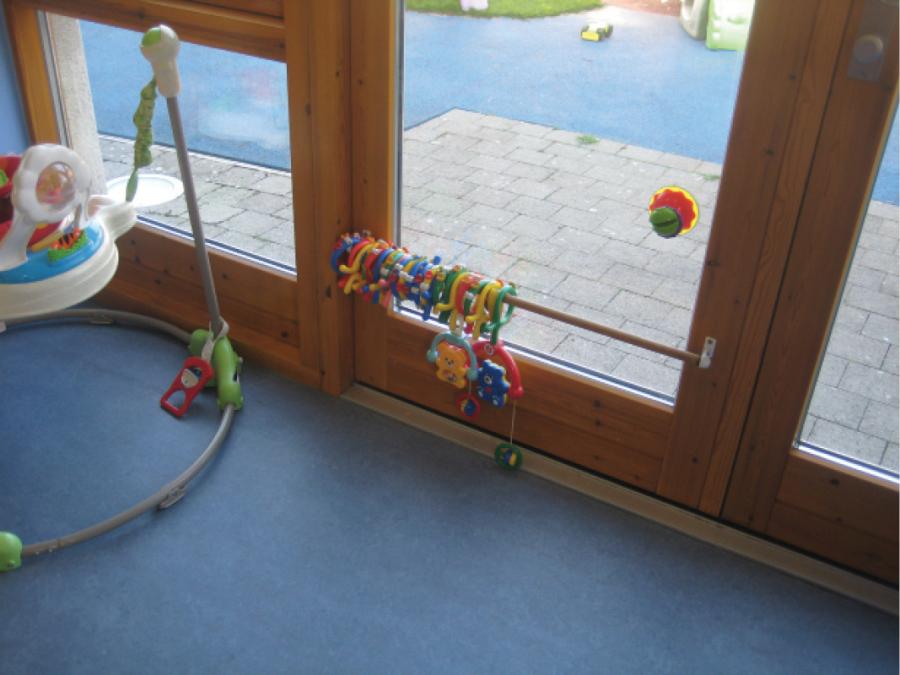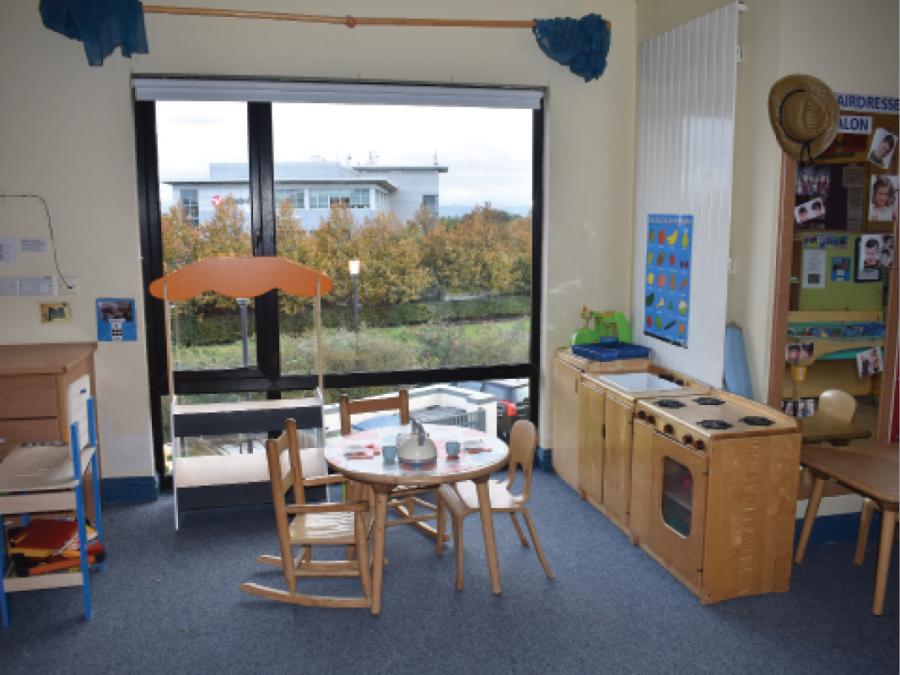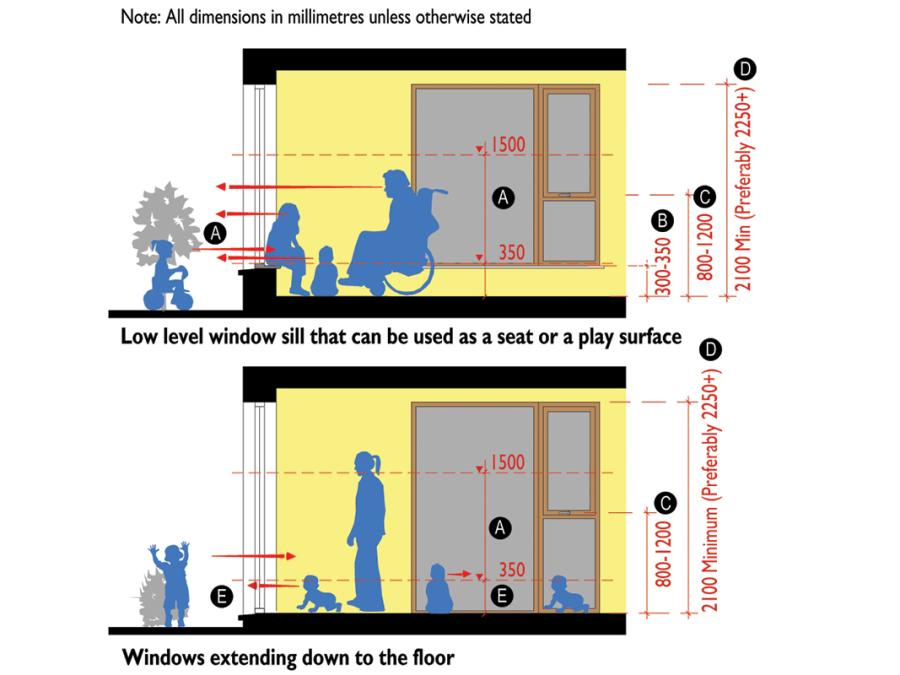Windows
Design considerations and awareness
The windows of an ELC setting control much of the interaction between inside and outside, not only in terms of views and daylight, but also in terms of sound and thermal insulation. Windows should provide maximum views to the outside, allowing children and adults to experience positive stimuli such as bird song, external activities, or the changing weather.
Window sills and transoms: Windows support the relationship with external spaces. Window sills and transoms should not obscure the view to outside. Remember the eye line of crawling babies or toddlers is much lower to the ground, so consider how windows enable them to see outside.

24. Carraig Briste, Enniscorthy, County Wexford
Carraig Briste, Enniscorthy, County Wexford.
Design features
Window providing a view to outside and a place to put plants or objects of interest to attract the attention of children.

25. Northside Family Resource Centre, Ballynanty, Limerick City
Northside Family Resource Centre, Ballynanty, Limerick City.
Design features
- High levels of glazing providing light and views to outside.
- Glazed door used to fit play rail that provides a multisensory experience for children while also attracting them to the outside.
Design tip
- Ensure items attached to a bar such as this do not pose a trip hazard when using the door or block the door in the event of evacuation.
- Fully glazed doors should have marking/manifestations between 850mm and 1000mm and 1400mm and 1600mm above floor level. This will make the glass visible from a range of eye levels and prevent people walking into the door.
Window operation: Windows should also be easily operated by staff, and while appropriate restrictors will be necessary in certain locations, consideration should be given to windows that can be safely used by children as part of their interaction and engagement with the setting.
Opening Sections: Windows should be designed so that if the opening section projects into the room that it does not present a collision hazard or takes up too much space within the room. Outward opening sections should not present a collision hazard, especially if it is at child height, for people using the space outside. This is particularly important where windows open onto play areas.

26. Tigers Childcare, Blanchardstown, Dublin.]
Tigers Childcare, Blanchardstown, Dublin.
Design features
- Windows extend all the way to the floor to provide extensive views to the outside for children sitting in seats or sitting/lying on the floor.
- Windows are fitted with safety restrictors that limit the opening of the window section to 100mm.
Design features
- If the colour of the handle contrasted with the colour of the window frame it would make this handle more visible.
Acoustic and thermal performance: Windows protect building occupants from disruptive external noise, solar glare or excessive solar heat gains, or conversely, heat loss. Therefore, the performance of the window in terms of U-Values, (how well insulated it is) acoustic insulation and solar transmittance (the amount of light permitted through the glazing) should be carefully considered.
Window dressing: Where curtains or blinds are used these must be carefully designed and installed so the pull cords or chains do not present a strangulation risk to children. For existing blinds with cords or chains replace these with solid wands or ensure all cords are beyond the reach of children. Only blinds that do not involve a cord or chain device are suitable in an ELC setting.
New blinds are manufactured so they do not contain cords or chains. These include motorised blinds, blinds operated by a gearbox and crank handle, or hand operated blinds that do not involve a cord but use side tracks or a spring- loaded mechanism or similar.
Note: For more information about blinds and associated safety issues see Tusla (2018) Quality and Regulatory Framework: Full Day Care Service and Part-Time Day Care Service.

Technical sketch 3: Indicative design of windows doors
A. Avoid window transoms between 350-1500mm for unobstructed views for at least one section of the window. This will provide unobstructed views to the outside for a range of people at different eye levels.
B. Window sill at 300-350mm off the ground will provide a place to sit or a surface to play on for small children. This also provides good views from the inside out, and from the outside, in terms of interaction and supervision.
C. Window that is easily opened with one hand with a lever handle between 800 and 1200mm from floor level. This handle should have a colour contrast to the window frame behind so it is easy to see.
D. The height of the window should be maximised to admit as much natural light as possible and also increase the view.
E. In some locations, such as spaces for babies or young toddlers, consider windows that extend all the way to the floor to provide views out for young children who are crawling or sitting.
Universal Design Guidance
- Consider the location and size of windows to admit high levels of natural light.
- Provide low-level sills or floor-length windows to maximise views to the outside and support visual development.
- Provide a combination of full-length windows and low-level sills of 300mm that afford a place for a small child to sit.
- Use high performance windows to achieve low U-Values, high levels of acoustic insulation and to control solar transmittance.
- Avoid window designs that place a transom between approximately 500 and 1500mm (or depending on the age group to be served) above floor level to provide unobstructed views to the outside.
- Ensure all existing blinds and curtains do not contain cords or chains that present a strangulation risk to children.
- Replace cords with solid curtain or blind wands.
- Select blinds that do not use cords or chains. Options include motorised blinds, blinds operated by a gearbox and crank handle, or hand operated blinds that do not involve a cord.




